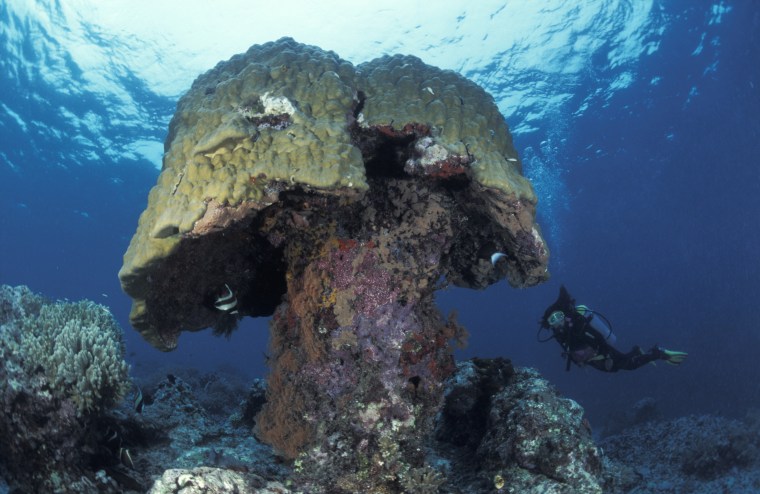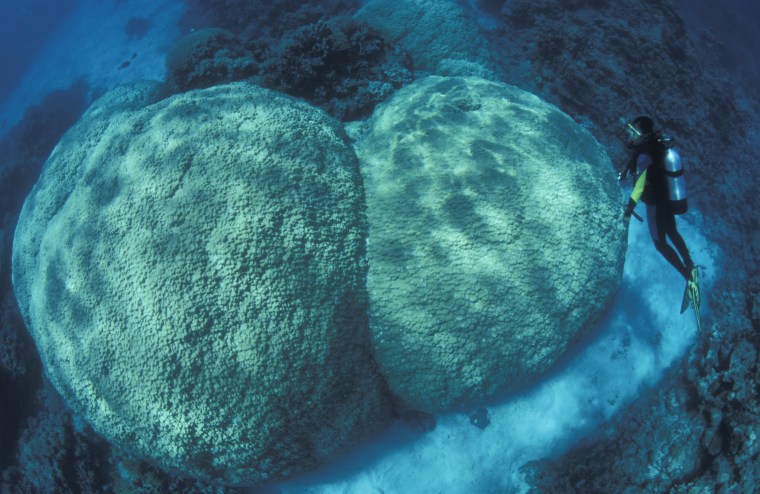The rate at which corals absorb calcium from seawater to calcify their hard skeletons — and thus grow — has declined dramatically in the last two decades and signs point to manmade greenhouse gas emissions as the culprit, according to a study of samples from Australia's Great Barrier Reef.
Researchers with the Australian Institute of Marine Science looked at the skeletal records of porites corals collected over the years at 69 reefs along the 1,600-mile-long Great Barrier Reef. Those corals, some 400 years old, showed that calcification declined by 13 percent between 1990 and 2005.
"The data suggest that such a severe and sudden decline in calcification is unprecedented in at least the past 400 years," the researchers stated in the study, published in the peer-reviewed journal Science.
A reef expert not involved in the study described it as "very important." In a commentary posted on newsvine.com for msnbc.com, John Bruno added that "the findings are frankly pretty scary."
"Slower growth might not seem like a big problem, but reef scientists are concerned that this will exacerbate the impacts of other threats to coral reefs," said Bruno, an associate professor of marine ecology at the University of North Carolina at Chapel Hill. "For example, it will slow the vertical growth of corals, making it harder for them to keep up with rising sea levels.
"It could also slow recovery from other disturbances such as coral bleaching episodes and destructive storms," Bruno added. Bleaching occurs when corals expel the organisms living inside that create the colors found on reefs.
The study's authors themselves wrote that "precipitous changes in the biodiversity and productivity of the world's oceans may be imminent" given how central coral reefs are to marine ecosystems.
Changes tracked via skeletal rings
The researchers sampled porites coral, which can grow over centuries into massive boulders. Porites also lay down annual growth rings, making it possible to compare specific years to water temperature records and other data.
Several potential causes were ruled out by the researchers, among them sewage and other runoff since many samples were originally far from the coast. Disease was also ruled out because the samples were all from corals that had been healthy.
That, they wrote, left "two most likely" factors, both tied to carbon dioxide emissions: warming sea temperatures and more acidic oceans as CO2 lowers the pH levels of the seas.
The researchers noted that their findings confirm lab experiments and computer models predicting negative impacts of rising carbon dioxide on corals.
"If temperature and carbonate saturation are responsible for the observed changes, then similar changes are likely to be detected in the growth records from other regions and from other calcifying organisms," they warned.
How fast can coral adapt?
Bruno noted that "we will almost certainly see this problem grow over the next few centuries" due to greenhouse gas emissions. "The only questions are by how much, how quickly corals can acclimate to climate change and what the broader impacts will be."

Bleaching has also been tied to warming waters, and adds to the pressure on corals. The Great Barrier Reef saw severe bleaching in 1998 and 2002 — the two hottest summers on record there — and officials warned that the northern end of the reef could see severe bleaching again over the next few months during the Southern Hemisphere's summer.
Bruno warned that while corals are not widely visible their role is critical. "Corals create the physical structure that thousands of other species depend on," he said. "They play a role analogous to trees that create forests. When corals die, so do the fish and invertebrate animals that live on reefs."
